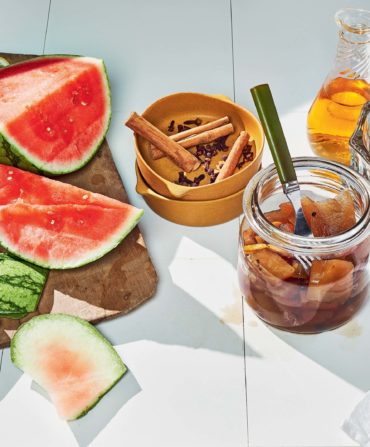I always look for pokeweed first. Right after the daffodils start to bloom but before the monarch butterflies come back, before the strawberries catch their color and asparagus gets that violet tinge, when the bluebirds start singing and the cardinals come around again, I know it’s time to start scanning the edges of the woods for the scarlet-stalked plant my family considers to be “good eating.” We aren’t the only ones fond of this towering weed found throughout the South. Indigenous people have used the pokeweed plant for herbal medicine for centuries, but its traditional Southern culinary preparation was probably born out of desperation. After families ate through their stockpiles of preserved food during a hard winter, pokeweed was one of the first edible greens to appear every year.
Pokeweed, or poke sallet, as it’s known once it’s cooked, is survival food. But it’s on par with morels for the complexity and versatility it can attain in the hands of a capable cook.
Often compared to spinach and less desired by mainstream cooks than ramps and lamb’s-quarter, pokeweed remains a sought-after delicacy for my family. It’s tough to cultivate, so hunting for the wild plant is an annual routine much like spring cleaning. Come early March, I start watching areas of disturbed earth and unkempt old homesites—places it likes to grow. I learned most of what I know about pokeweed from my paternal grandmother, Grandma Mary. It’s known to be toxic when not prepared correctly, and there are many rules she taught me about harvesting the plant—don’t pick it near roadways because of the exhaust and pesticides, don’t eat the plum-colored berries, and don’t mess with the root, the most poisonous part. When it comes to cooking pokeweed, the main thing to remember is to boil the leaves twice to get rid of the toxins.
There are songs about the plant, like “Polk Salad Annie,” and stories, folktales really, about what happens to people who disobey the elders’ warnings. I have two cousins, Chris and Larry, who can never get along, and their childhood shenanigans at family gatherings were always slightly over the top, like putting peaches in a rival’s tailpipe. The way Grandma told it, their mother ate the berries from the pokeweed plant when she was pregnant with them, and they never stood a chance of being normal.
Everybody in my family puts their own spin on poke sallet. I like to fold my boiled leaves into a quiche, and my father used to sauté his harvest with onions and eggs. Grandma Mary made hers the traditional way, as we would prepare tender turnip or mustard greens—a little salted pork for flavoring, with some cornbread on the side to round out the meal.
This article appears in the August/September 2020 issue of Garden & Gun. Start your subscription here or give a gift subscription here.








